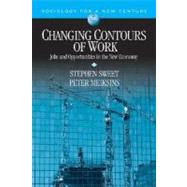
Note: Supplemental materials are not guaranteed with Rental or Used book purchases.
Purchase Benefits
What is included with this book?
| List of Exhibits | p. ix |
| About the Authors | p. xv |
| Preface | p. xvii |
| Acknowledgments | p. xxi |
| Mapping the Contours of Work | p. 1 |
| Scenes From the New Economy | p. 3 |
| Culture and Work | p. 6 |
| Structure and Work | p. 11 |
| Class Structures | p. 12 |
| Job Markets and Job Demands | p. 13 |
| Demography and the New Labor Force | p. 16 |
| Agency and Careers | p. 18 |
| Conclusion | p. 20 |
| How New Is the New Economy? | p. 23 |
| The Old in the New | p. 24 |
| A Post-Industrial Society? | p. 24 |
| The End of Mass Production? | p. 26 |
| New Cultures of Control? | p. 30 |
| The End of Organized Labor? | p. 32 |
| A New Global Economy? | p. 36 |
| The Old in the New: A Summary | p. 38 |
| Class Chasms in the New Economy | p. 38 |
| Class and Opportunity in the United States | p. 39 |
| Class and Opportunity in the Developing World | p. 44 |
| Are International Economic Divides Widening or Narrowing? | p. 46 |
| Conclusion | p. 51 |
| Gender Chasms in the New Economy | p. 53 |
| When did Home Work Become Nonwork? | p. 54 |
| Women's Participation in the Paid Labor Force in America | p. 57 |
| Gender Inequalities in Compensation | p. 59 |
| Socialization, Career Selection, and Career Paths | p. 61 |
| Interpersonal Discrimination in the Workplace | p. 68 |
| Structural Dimensions of Gender Discrimination | p. 73 |
| The Devaluation of Women's Work | p. 74 |
| How Job Designs Discriminate | p. 75 |
| Strategies to Bridge the Care Gaps: International Comparisons | p. 78 |
| Conclusion | p. 84 |
| Race, Ethnicity, and Work: Legacies of the Past, Problems in the Present | p. 87 |
| Histories of Race, Ethnicity, and Work | p. 88 |
| African American Exceptionality | p. 88 |
| The Immigrant Experience | p. 90 |
| The Magnitude of Racial Inequality in the New Economy | p. 93 |
| Intergenerational Transmission of Resources | p. 96 |
| Race, Ethnicity, and Economic Capital | p. 97 |
| Race, Ethnicity, and Human Capital | p. 98 |
| Race, Ethnicity, and Social Capital | p. 100 |
| Race, Ethnicity, and Cultural Capital | p. 102 |
| Geographic Distribution of Race and Work Opportunity | p. 104 |
| Racial Discrimination | p. 107 |
| Prejudice and Discrimination | p. 107 |
| Racialized Jobs | p. 109 |
| Race, Ethnicity, and Work: Social Policy | p. 110 |
| Affirmative Action | p. 111 |
| Immigration Policy | p. 113 |
| Conclusion | p. 117 |
| Whose Jobs Are Secure? | p. 119 |
| Risk and Work: Historical and Comparative Views | p. 120 |
| How Insecure Are Workers in the New Economy? | p. 125 |
| The Costs of Job Loss and Insecurity | p. 130 |
| Responding to Insecurity: Old and New Careers | p. 134 |
| Conclusion | p. 139 |
| A Fair Day's Work? The Intensity and Scheduling of Jobs in the New Economy | p. 141 |
| Time, Intensity, and Work | p. 142 |
| How Long Are We Working? Comparative Frameworks | p. 145 |
| Working Long, Working Hard | p. 151 |
| Why Are Americans Working So Much? | p. 153 |
| Nonstandard Schedules: Jobs in a 24/7 Economy | p. 157 |
| How Americans Deal With Overwork | p. 160 |
| Conclusion | p. 163 |
| Reshaping the Contours of the New Economy | p. 165 |
| Opportunity Chasms | p. 166 |
| Class Chasms | p. 166 |
| Gender Chasms | p. 167 |
| Racial and Ethnic Chasms | p. 168 |
| International Chasms | p. 169 |
| The Agents of Change | p. 171 |
| The Role of Individuals | p. 171 |
| The Role of Activist Groups | p. 173 |
| The Role of Organized Labor | p. 175 |
| The Role of Employers | p. 179 |
| The Role of Government | p. 182 |
| The Role of International Organizations | p. 187 |
| Conclusion | p. 192 |
| Legislative and Regulatory Timeline of Worker Rights and Protections in the United States | p. 195 |
| References | p. 201 |
| Index | p. 231 |
| Table of Contents provided by Ingram. All Rights Reserved. |
The New copy of this book will include any supplemental materials advertised. Please check the title of the book to determine if it should include any access cards, study guides, lab manuals, CDs, etc.
The Used, Rental and eBook copies of this book are not guaranteed to include any supplemental materials. Typically, only the book itself is included. This is true even if the title states it includes any access cards, study guides, lab manuals, CDs, etc.